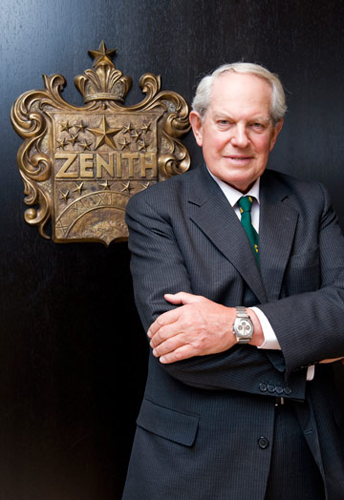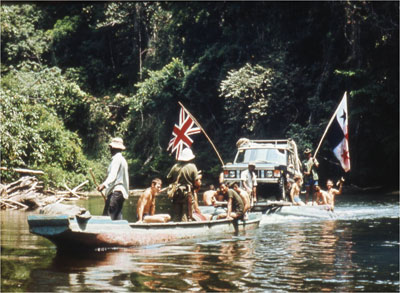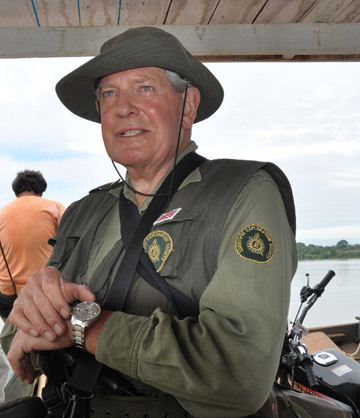Jean-Frédéric Dufour, CEO of the Zenith watchmaking manufacturer, has just announced the return of Colonel John Blashford-Snell to the circle of Zenith ambassadors. This title confirms a longstanding reality. For the last 40 years, the British explorer has proudly worn a Zenith El Primero chronograph on his expeditions across the world, since he participated in the great British trans-americas mission – 29,000 km from Alaska to the Tierra del Fuego (land of fire), through the previously impenetrable swampy jungle of the complete Darién gap. Colonel Blashford-Snell has organised and directed more than 100 expeditions during which his El Primero chronograph has been through the worst possible conditions : the intense cold of Alaska, extreme humidity of the swamps of Central and South America, the jungles on the banks of the Blue Nile and Congo river, desert sand… today, like a hand that has completed a sweep of the dial, this chronograph (which still works perfectly !) has come back to Le Locle, because the Colonel has just donated it to the future Zenith museum. Rightly so, the manufacture Zenith is paying tribute to this exceptional person by launching a John Blashford-Snell limited edition inspired by the El Primero stratos flyback model.

The beginnings of an explorer's vocation
What chronograph can claim to have withstood such a test of its resistance and reliability by spending more than 40 years on the wrist of one of the most tireless explorers of modern times ? For that is definitely how Colonel Blashford-Snell is best described. His adventures began in 1968, when the Emperor Haile Selassie of Ethiopia invited the British army to put together an expedition to attempt the first descent of the Blue Nile. John Blashford-Snell led this project. In 1969, once the mission was accomplished, he returned to England, and founded the Scientific Exploration Society in order to encourage and promote scientific exploration across the world. (It is worth pointing out at this juncture that the El Primero movement was launched that same year).
His expeditions always had scientific, medical, geographical or environmental objectives. After the Blue Nile, he needed a new challenge, which turned out to be one of his most challenging missions – the British Trans-Americas – crossing the American continent from the extreme north to the extreme south. The main challenge was the crossing of the complete Darién Gap in a motor vehicle. This is a swampy jungle area, 400 km long, up until then thought to be completely impassable (see box). Following this exploit, the “Pan American Highway Authority” administration, responsible for the great road that connects the very north of the Americas, to the extreme south, aimed to spend the 150 million dollars required to build the last stretch of the Pan American Highway that would cross the Darién Gap, taking the same route as this glorious epic. After this expedition, John Blashford-Snell continued to wear the ZENITH El Primero chronograph that was given to him by the watchmaking manufacturer for the occasion.
A life dedicated to exploration and discovery
John Blashford-Snell also took part in new adventures, the one that first springs to mind is the descent of the entire 4700 km length of the Congo River in 1974-1975. He was also committed to sharing his passion, doing this through Operation Drake from 1978 to 1980 (a project in which 400 young people from 27 nations took part, sailing a British ship transformed into a floating laboratory which accomplished a number of exploratory missions), followed by Operation Raleigh from 1984 to 1992. Having retired from the British Army in 1991 after 37 years of service, Colonel Blashford-Snell continued to lead similar projects, undertaking a series of explorations of South American rivers, seeking archaeological remains and scientific observations (Kota Mama Expeditions). Most recently, from 2009-2010, he directed a hunt for a meteorite in Bolivia and studied giant elephants in the Nepalese jungle. In 2011, he launched an expedition in Mongolia, in the Gobi desert. At nearly 75, he has lost nothing of his drive !

John Blashford-snell : the same “pioneering spirit”
In 1974, John Blashford-Snell was awarded the Segrave Trophy for “Courage, Initiative, Skill and Spirit of Adventure” that he had demonstrated so often, and for his participation in “the Development of Air, Land, River and Sea Transport”. The medals awarded to him by the Royal Geographical Society and the Institute of Royal Engineers attest to his missions' contribution to the progress of knowledge. The Colonel is currently President of the Scientific Exploration Society, and the water charity Just a Drop. He has held the Order of the British Empire since 1991 for his action in the context of the Operation Raleigh, which contributed to developing a sense of initiative and responsibility in young people (many of them from underprivileged backgrounds), and making them “true young pioneers”.
All of these distinctive qualities demonstrate a certain mindset, which combines an enterprising spirit, a will to excel by constantly taking on new challenges; a passion for knowledge and discovery ; as well as a deep sense of human values. This mindset exactly mirrors that of the Manufacture ZENITH, that brand CEO Jean-Frédéric Dufour sums up as follows : ”The expression ‘pioneering spirit' best defines the ZENITH brand, which has often been a trailblazer in uncharted territory. What is remarkable about ZENITH is this ability to give birth to new ideas, and then commit to new technical challenges. Our watches have accompanied some of the greatest human adventures : the discovery of the North and South poles, conducted by the explorer Roald Amundsen ; Mahatma Ghandi's peaceful struggle for Indian independence ; the ecological principles of Crown Prince Albert 1st of Monaco ; Louis Blériot's Channel crossing ; John F. Kennedy's political activities ; and the solo flight of the North Pole in a hot air balloon by French doctor Jean-Louis Etienne, to name but a few.” It was only right that Colonel John Blashford-Snell's name be officially engraved as an ambassador of the brand alongside the list of illustrious personalities who have chosen ZENITH chronographs.

Zenith, a passion for innovation
Instead of resting on his laurels after the success of the British Trans-Americas expedition, John Blashford-Snell constantly took on new explorations ! Similarly, as a remarkable pioneer in its own right, the Manufacture ZENITH could have continued to reproduce identical El Primero mechanisms to the one the Colonel has put to the test for its reliability since 1971. Created two years previously, the El Primero calibre was the first mechanical movement in the world to beat at a rate of ten vibrations per second, whereas all existing ones achieved eight vibrations per second at best. But even after having surpassed a barrier that was considered unbeatable, ZENITH remained driven by a tireless spirit of discovery, and was responsible for equipping the El Primero with new complications. ZENITH is currently marketing a 500-piece El Primero Stratos Flyback special edition christened John Blashford-Snell in tribute to its faithful ambassador. The Colonel personally participated in developing the specifications. He wanted “an ultra-resistant instrument with exceptional readability”. The results a steel case and bracelet, silver-toned dial and black counters for maximum contrast, with Super-LuminovaTM on the hands and hour-markers. This “Special Mission” watch is equipped with a flyback function, a unidirectional rotating bezel and a telemetric scale on the inner bezel ring.
The British trans-americas expedition, 1971-1972
ZENITH has always supported daring projects and people seeking to push physical or intellectual limits as far as possible. In 1971-1972, the Manufacture was therefore amongst the companies that supported the British Trans-Americas Expedition. This was right at the beginning of adventure sponsorship, which has since become a widespread practice. Although many members of the expedition came from the British armed forces, in close cooperation with the Columbian, Panamanian and US armed forces, Range Rover supplied the two vehicles (two models from a series initially intended for exportation to Switzerland), Marks & Spencer supplied the clothes, Heinz the food… ZENITH supplied the watches to the whole team and equipped the leader, John Blashford-Snell, with a watch powered by its latest and most accurate calibre : the El Primero Chronograph.

After a year of tough training, the expedition left from Anchorage on December 3rd 1971, initially crossing Alaska, and the Yukon, in the snow and on frozen roads. In Canada, one of the Range Rovers had an accident, but it was repaired from Vancouver. The expedition reached San Francisco on December 23rd and thereafter Los Angeles on the 24th. Still going south, they crossed Mexico and South America, arriving in Panama City on January 12th.
The toughest part of the expedition started here – the Darién Gap – known locally as El Tapón “the plug”, known in English as “The Gap”– a gap of some 400 km in the Pan-American Highway, an area completely devoid of any useable road in many places, where rare tracks in the jungle were known only to locals. Usually, cars went around this extensive area of tropical swamps on boats. Crossing El Tapón appeared impossible and far too dangerous due to the hostile bandits, disease and aggressive fauna.
It was the aim of this expedition to study the fauna and flora and to open a passage. They started on January 19th 1972, when the rainy season, which was five weeks longer than usual, had turned the rare passages of terra firma into thick, black glutinous mud. The path was hacked with a machete and chain saw or using aluminum ladders over certain obstacles, fording the worst areas. The progress was slow – averaging barely 3 km per day – while a mistake in the route resulted in losing ten days. Despite these difficulties, due to incredible strength and tenacity, after 96 days, on April 23rd 1972, the expedition regained solid ground, after the final crossing of the great Atrato swamp. For the first time, motor vehicles had vanquished the complete El Tapón.

After a thorough overhaul of the Range Rovers, the expedition continued its route right down South America – Colombia, Ecuador, Chile, Patagonia and the Land of Fire (Tierra del Fuego)… They arrived at Ushuaia and Cape Horn on June 10th 1972, after a 29,000 km trip. An achievement that is comparable, albeit on a completely different scale, to that accomplished by the El Primero movement with its 36,000 vibrations per hour…!!!




